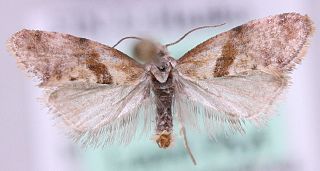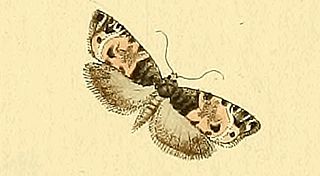
The Tortricidae are a family of moths, commonly known as tortrix moths or leafroller moths, in the order Lepidoptera. This large family has over 11,000 species described, and is the sole member of the superfamily Tortricoidea, although the genus Heliocosma is sometimes placed within this superfamily. Many of these are economically important pests. Olethreutidae is a junior synonym. The typical resting posture is with the wings folded back, producing a rather rounded profile.

Spilonota ocellana, the bud moth, is a moth of the family Tortricidae. It is found in the Palearctic realm, from North Africa and Europe to Iran, eastern Russia, China, Korea, and Japan. It is also present on Madeira and in North America.

Choristoneura murinana is a moth of the family Tortricidae. It is found in central Europe and the Near East, China, Taiwan and in North America.

Eucosma conterminana, the lettuce tortricid, is a moth of the family Tortricidae.

Notocelia cynosbatella is a moth of the family Tortricidae. It is found from Europe to eastern Russia, it is also found in Asia Minor, Iran, Kazakhstan, China and Mongolia.
Spilonota eremitana, the larch leafroller, is a moth of the family Tortricidae. It is found in Japan, China, Russia and the Korean Peninsula.
Spilonota lechriaspis, the apple fruit licker, is a moth of the family Tortricidae. It is found in eastern Russia, China, the Korean Peninsula and Japan.

Zeiraphera ratzeburgiana, the spruce bud moth or Ratzeburg tortricid, is a moth of the family Tortricidae. It is found from northern and central Europe to eastern Russia and China. Zeiraphera ratzeburgiana is a taxonomically similar species to Zeiraphera canadensis and can only be distinguished by an anal comb found in Z. canadensis.
Zeiraphera rufimitrana, the red-headed fir tortricid, is a moth of the family Tortricidae. It is found from central Europe to eastern Russia, Mongolia, the Korean Peninsula, China and Japan. It was first recorded from the Netherlands by Kuchlein and Naves in 1999.
Cydia kurokoi, the nut fruit tortrix, is a moth of the family Tortricidae. It is found in Japan, the Korean Peninsula and eastern China.

Ancylis upupana is a moth of the family Tortricidae. It is found in most of Europe, east to Russia and China.

Cochylidia implicitana, the chamomile conch, is a moth of the family Tortricidae. It was described by Wocke in 1856. It is found in most of Europe, except Ireland and most of the Balkan Peninsula. Outside of Europe, it is found in Morocco, the Alatau mountains in Central Asia, Iran and China (Xinjiang). The habitat consists of waste ground and verges.

Choristoneura luticostana is a species of moth of the family Tortricidae. It is found in China, the Korean Peninsula, the Russian Far East and Japan. The habitat consists of fir-broad-leaved and cedar-broad-leaved forests.

Choristoneura longicellanus is a species of moth of the family Tortricidae. It is found in China, Japan, Taiwan, the Korean Peninsula and the Russian Far East.

Notocelia incarnatana, the chalk rose bell, is a species of moth of the family Tortricidae. It is found in China, Mongolia, Japan, Russia, Kazakhstan and Europe, where it has been recorded from most of the continent, except parts of the Balkan Peninsula.

Notocelia tetragonana, the square-spot bell, is a species of moth of the family Tortricidae. It is found in China, Russia and Europe, where it has been recorded from most of the continent, except the Iberian Peninsula, the Netherlands, Denmark and most of the Balkan Peninsula. The habitat consists of woodland and scrubland.
Spilonota albicana, the white fruit moth, larger apple fruit moth or eye-spotted bud moth, is a species of moth of the family Tortricidae. It is found in China, Korea, Japan and Russia. It has been accidentally introduced in the Netherlands.
Spilonota pyrusicola is a species of moth of the family Tortricidae. It is found in China.
Ptycholoma imitator is a species of moth of the family Tortricidae. It is found in China, the Korean Peninsula, Japan and Russia. The habitat consists of oak forests, cedar broad-leaved forests, fir broad-leaved forests, valley broad-leaved forests and gardens.

Ptycholomoides aeriferana, the larch twist, is a species of moth of the family Tortricidae. It is found in China (Heilongjiang), the Korean Peninsula, Japan, Russia and most of Europe.













